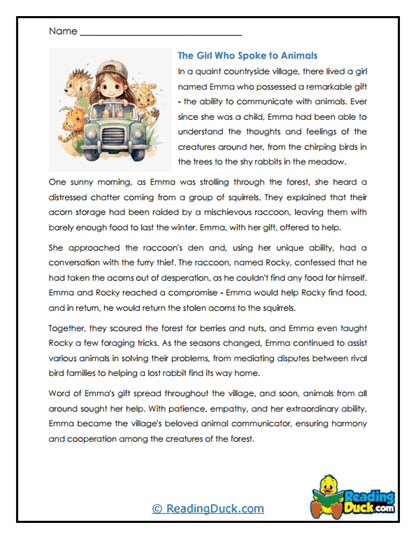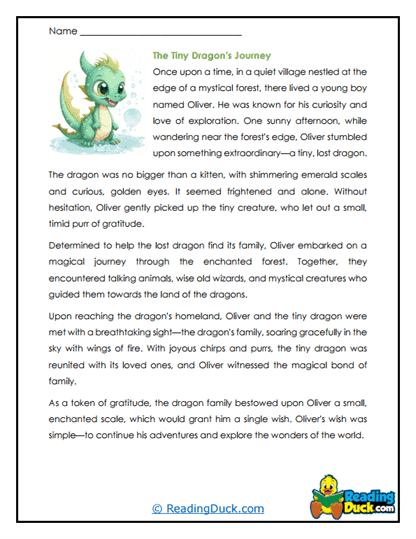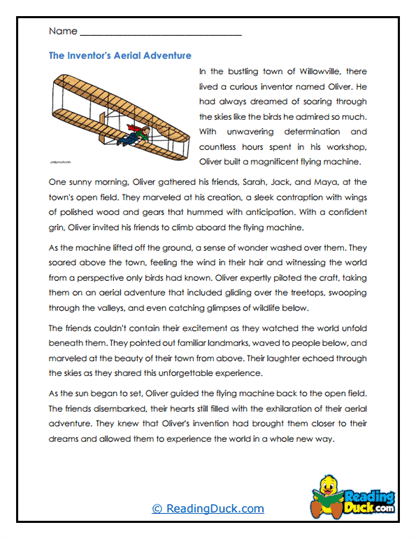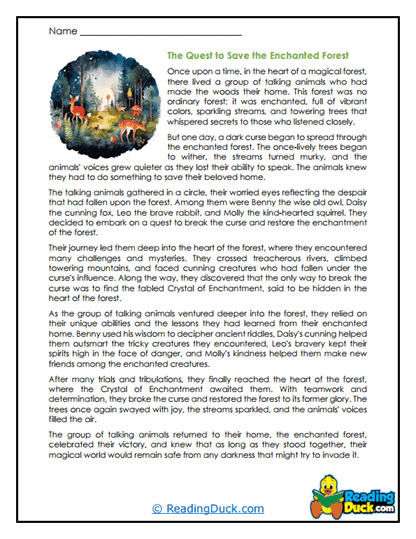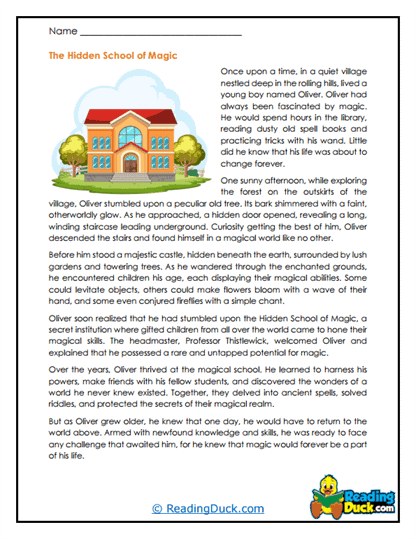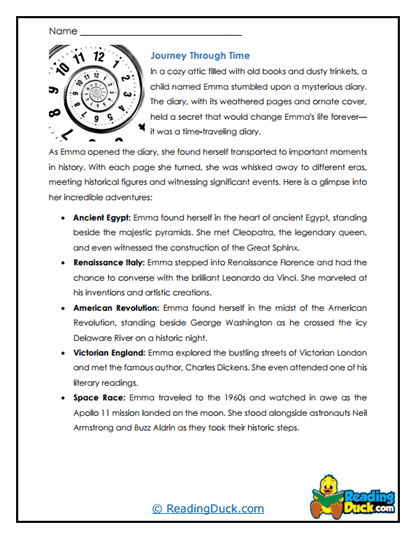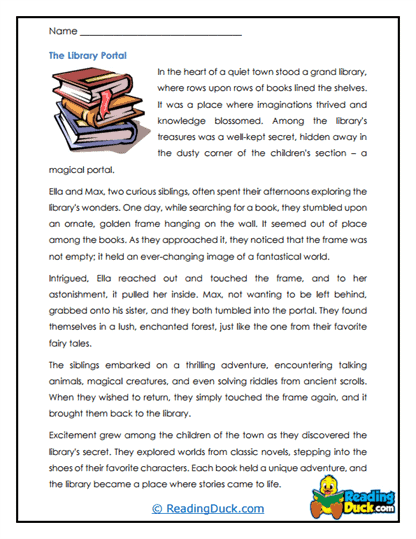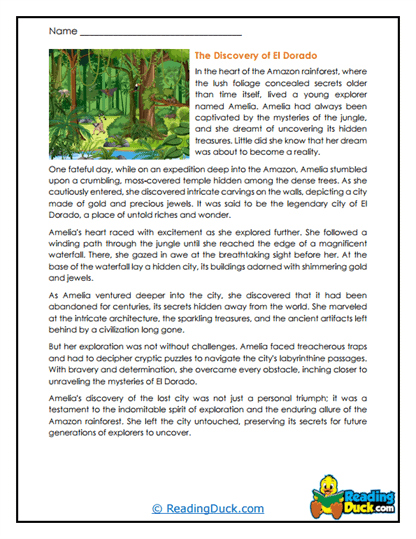Fiction Passages with Questions Worksheets
About Our Fiction Passages with Questions Worksheets
Our Fiction Passages with Questions Worksheets are expertly crafted to help students engage with diverse genres of fiction, from adventure and fantasy to historical and dystopian fiction. Each worksheet set includes a carefully selected reading passage that aligns with a specific genre of fiction, along with an array of multiple-choice, short-answer, and open-ended questions designed to test and enhance students' reading comprehension and analytical skills.
These worksheets are presented in PDF format, making them simple to download, view, and print for easy use in the classroom or at home. Additionally, each set includes a downloadable answer key, which allows teachers to efficiently grade and review student responses. The worksheets serve as an excellent tool for fostering individual exploration or collaborative learning, offering students a structured yet flexible way to interact with the text and deepen their understanding of fiction.
Through these Fiction Passages with Questions Worksheets, students will not only sharpen their reading and comprehension skills but also develop critical thinking abilities, creative interpretation, and a deeper appreciation for the varied elements that make fiction such a rich and compelling literary genre.
Understanding Fiction: Themes, Techniques, and Importance
Fiction is a broad and dynamic genre that explores the human experience through imaginative storytelling. Whether set in familiar, everyday settings or in fantastical worlds, fiction gives readers insight into the complexity of emotions, relationships, and conflicts. Key themes in fiction often revolve around growth, morality, conflict, love, loss, identity, and human nature. The genre’s diversity allows for endless narrative possibilities, from fast-paced adventures to quiet, introspective explorations of a character’s inner world.
Fiction uses various narrative techniques that enrich the storytelling experience, including character development, dialogue, descriptive language, symbolism, and plot structure. Characters in fiction often face personal challenges or societal obstacles that prompt growth, change, or realization. Readers are drawn into these stories not only by the plot but also by the emotional and psychological depth of the characters and the narrative.
The study of fiction is an essential element in education because it encourages critical thinking, empathy, and an understanding of different perspectives. Through analyzing fiction, students learn to recognize the nuances of language, the impact of narrative choices, and how stories can reflect larger societal issues or personal struggles. Fiction often provides a mirror to the real world, even when set in imagined or far-fetched scenarios, making it a powerful tool for personal and intellectual growth.
Our Fiction Passages with Questions Worksheets guide students through these themes and techniques, helping them understand how fiction operates on multiple levels, from plot and character to theme and symbolism. The questions encourage students to explore both the literal and metaphorical aspects of fiction, providing them with the skills to analyze and interpret stories effectively.
Structure of the Worksheets: Engaging with Fiction Passages
Each set of Fiction Passages with Questions Worksheets begins with a reading passage that represents a specific genre of fiction, whether it’s a gripping adventure, a thoughtful historical narrative, or a mysterious fantasy world. The passages are chosen to reflect key elements of their respective genres, offering students an opportunity to see how different fiction techniques play out in diverse settings and storylines.
Following the reading passage, students are presented with various question types:
- Multiple-choice questions help students focus on key details from the passage, such as identifying the main conflict, understanding character motivations, or recognizing significant plot developments. These questions serve as a foundational assessment of reading comprehension.
- Short-answer prompts encourage students to dive deeper into the text, asking them to analyze specific elements such as the role of setting in shaping character behavior, the significance of an event, or how a theme is developed through the dialogue or narrative structure.
- Open-ended response questions provide students with an opportunity for creative engagement and interpretation. These prompts may ask students to explore how the story might change if a key event unfolded differently, to imagine alternate endings, or to draw connections between the themes of the passage and broader real-world issues.
For example, after reading a passage from an adventure story, students might be asked, “How does the protagonist’s encounter with the antagonist propel the plot forward?” or “What would happen if the hero failed to overcome the main obstacle?” These types of questions foster critical thinking by asking students to reflect on the narrative’s structure and make predictions based on the characters’ actions and motivations.
Encouraging Critical Thinking and Creative Exploration
The Fiction Passages with Questions Worksheets are designed not only to test comprehension but also to stimulate critical thinking and creative exploration. Fiction as a genre encourages readers to think beyond the surface, and our worksheets reflect this by incorporating open-ended and thought-provoking questions that push students to analyze the deeper meanings and implications within the stories.
The open-ended response questions are particularly effective in fostering critical thinking. These questions often prompt students to consider character motivations, the impact of setting and context, or the significance of a symbol or theme within the narrative. For example, students might be asked to consider, “What does the setting symbolize in this story, and how does it influence the characters' choices?” or “How does the author use dialogue to reveal the underlying tension between characters?”
By reflecting on these elements, students develop a stronger ability to interpret fiction and understand the ways in which authors convey meaning through narrative techniques and literary devices. These questions also challenge students to engage with the story on a personal level, allowing them to explore how fictional situations relate to real-life experiences or broader societal themes.
In addition to analytical tasks, the worksheets encourage creative thinking by prompting students to reimagine the story in new and inventive ways. For instance, students might be asked to rewrite the ending of a passage, invent a new character to introduce into the story, or expand on a specific scene by adding more detail or changing a key event. These activities help students develop their own creative voice while deepening their understanding of how fiction is constructed.
Versatile Use for Individual and Group Learning
The Fiction Passages with Questions Worksheets are flexible and adaptable, making them an ideal resource for both individual study and group-based learning. Teachers can use these worksheets to initiate classroom discussions, group projects, or peer review sessions. In a group setting, students might work together to analyze the passage, share different interpretations, and debate the choices made by the characters or the author.
Group discussions can focus on topics such as, “How do the setting and time period influence the characters' decisions in this historical fiction passage?” or “What might happen if the fantasy world’s rules were altered, and how would that change the outcome of the story?” These collaborative activities promote critical discussion and allow students to explore multiple perspectives, enhancing their analytical skills.
For individual learners, the worksheets offer a structured yet flexible approach to self-guided exploration of fiction. Students can work through the questions at their own pace, starting with the multiple-choice section to solidify their understanding of the passage before moving on to the more open-ended, reflective questions. This makes the worksheets ideal for homework, independent projects, or remote learning environments.
Inspiring Creative Interpretation and Imagination
One of the most powerful aspects of fiction is its ability to inspire creative interpretation and spark the imagination. The Fiction Passages with Questions Worksheets capitalize on this by encouraging students to not only analyze the text but also imagine how the story could unfold in different ways. These creative tasks allow students to engage with the narrative on a personal level, exploring how changes in character decisions, plot twists, or setting might affect the overall message of the story.
For instance, students might be asked to create an alternate ending to a dystopian fiction passage or rewrite a scene from a different character’s perspective. These exercises challenge students to think creatively while reinforcing their understanding of narrative structure, character arcs, and thematic development.
By encouraging students to experiment with plot, setting, and character, the worksheets foster a deeper appreciation for fiction as both a literary form and a creative outlet. Students learn to see fiction not just as a fixed narrative but as a flexible and dynamic form of storytelling that invites innovation and reinterpretation.
Conclusion
Our Fiction Passages with Questions Worksheets offer a comprehensive and engaging tool for students to explore the richness and diversity of fiction. With a blend of multiple-choice, short-answer, and open-ended questions, these worksheets help students enhance their reading comprehension, critical thinking, and creative interpretation skills while engaging with a variety of genres.
Whether used for individual study or in group discussions, the worksheets provide a versatile and effective resource for delving into the key elements of fiction, from character development and plot structure to symbolism and theme analysis. By encouraging both analytical thinking and creative exploration, the Fiction Passages with Questions Worksheets empower students to appreciate the depth and complexity of fiction, fostering a lifelong love for reading and storytelling.
